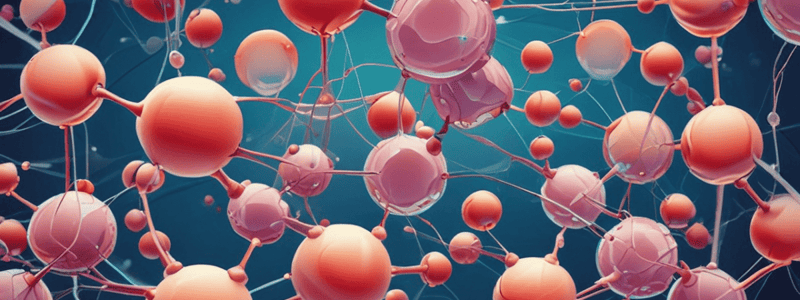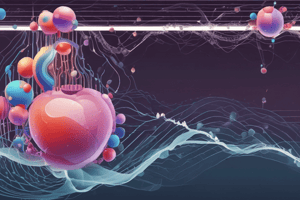Podcast
Questions and Answers
What is the characteristic of polyunsaturated fatty acids?
What is the characteristic of polyunsaturated fatty acids?
- Having more than one double bond (correct)
- Having one double bond
- Having a fixed number of double bonds
- Having no double bonds
Which type of fatty acid has the first double bond at carbon 3 in relation to the ω carbon?
Which type of fatty acid has the first double bond at carbon 3 in relation to the ω carbon?
- ω6 fatty acid
- ω3 fatty acid (correct)
- ω7 fatty acid
- ω9 fatty acid
What is the function of prostaglandin and eicosanoids synthesized from polyunsaturated fatty acids?
What is the function of prostaglandin and eicosanoids synthesized from polyunsaturated fatty acids?
- Participating in blood clotting (correct)
- Energy production
- Cellular membrane structure
- Skin integrity
What is rancidity?
What is rancidity?
Which type of rancidity is caused by bacterial contamination at high temperature and moisture?
Which type of rancidity is caused by bacterial contamination at high temperature and moisture?
What is the most common natural antioxidant?
What is the most common natural antioxidant?
What is a hazard of consuming rancid fats?
What is a hazard of consuming rancid fats?
What is the purpose of adding antioxidants to fats?
What is the purpose of adding antioxidants to fats?
What is the main characteristic of lipids?
What is the main characteristic of lipids?
What is the general formula of saturated fatty acids?
What is the general formula of saturated fatty acids?
What is the function of lipids in absorption?
What is the function of lipids in absorption?
What is the main difference between saturated and unsaturated fatty acids?
What is the main difference between saturated and unsaturated fatty acids?
What is the classification of lipids that include fats and waxes?
What is the classification of lipids that include fats and waxes?
What is the function of subcutaneous fat?
What is the function of subcutaneous fat?
What is the term for fatty acids that cannot be synthesized in the body?
What is the term for fatty acids that cannot be synthesized in the body?
What is the term for lipids that are soluble in water?
What is the term for lipids that are soluble in water?
What is affected by rancidity?
What is affected by rancidity?
What are acylglycerols?
What are acylglycerols?
What is the main component of dental calculus?
What is the main component of dental calculus?
What is the result of hydrolysis of simple and compound lipids?
What is the result of hydrolysis of simple and compound lipids?
What is the primary function of lipase enzyme?
What is the primary function of lipase enzyme?
What type of lipids are found in saliva?
What type of lipids are found in saliva?
What is the consequence of rancidity?
What is the consequence of rancidity?
Which of the following is a derived lipid?
Which of the following is a derived lipid?
Flashcards are hidden until you start studying
Study Notes
Introduction to Lipids
- Lipids are hydrophobic small molecules formed from alcohol and fatty acids combined together by an ester bond.
- Lipids include fats, waxes, sterols, fat-soluble vitamins, and phospholipids.
- Lipids are insoluble in water but soluble in organic solvents such as ether, benzene, acetone, and chloroform.
Biomedical Importance of Lipids
- Lipids are a source of energy due to their high energy value.
- Lipids are structural components of cell membranes (phospholipids and cholesterol).
- Lipids act as metabolic regulators (e.g., steroid hormones).
- Lipids help in the absorption of fat-soluble vitamins (A, D, E, and K).
- Lipids protect internal organs by providing a cushioning effect (pads of fat).
- Lipids provide insulation against changes in external temperature (subcutaneous fat).
Classification of Lipids
- Simple lipids are esters of fatty acids with various alcohols.
- Fatty acids may be saturated or unsaturated, and essential or nonessential.
Saturated and Unsaturated Fatty Acids
- Saturated fatty acids have no double bonds in their chain.
- Saturated fatty acids have a general formula of CH3-(CH2)n-COOH.
- Unsaturated fatty acids contain one or more double bonds.
- Unsaturated fatty acids are either monounsaturated or polyunsaturated.
Polyunsaturated Fatty Acids (PUFA)
- PUFA are classified according to the position of the first double bond in relation to ω carbon.
- PUFA are classified into ω3, ω6, ω7, and ω9 fatty acids.
- Functions of PUFA include:
- Preventing atherosclerosis
- Synthesizing prostaglandins and eicosanoids
- Participating in the structure of all cellular and subcellular membranes
- Maintaining skin integrity, normal growth, and reproduction
- Playing an important role in blood clotting
- Preventing and treating fatty liver
- Maintaining the health of the retina and vision
Rancidity
- Rancidity is a physico-chemical change in the natural properties of fat leading to unpleasant odor, taste, or color.
- Types of rancidity include:
- Hydrolytic rancidity
- Oxidative rancidity
- Ketonic rancidity
- Prevention of rancidity is achieved by:
- Avoiding the causes of rancidity
- Keeping fats or oils in well-closed containers in a cold, dark, and dry place
- Adding antioxidants
- Hazards of rancid fats include:
- Toxicity and food poisoning
- Destruction of fat-soluble vitamins
- Destruction of polyunsaturated essential fatty acids
- Economical loss
Simple Lipids
- Simple lipids are formed from alcohols and fatty acids.
- There are two classes of simple lipids: acylglycerols and waxes.
Compound Lipids
- Compound lipids contain in addition to esters of fatty acids with alcohols, other groups.
- Compound lipids are classified into phospholipids, glycolipids, sulfolipids, and lipoproteins.
Derived Lipids
- Derived lipids are produced when simple and compound lipids combine and undergo hydrolysis.
- Derived lipids include cholesterol, carotenes, steroids, prostaglandins, ketone bodies, and fat-soluble vitamins.
The Role of Lipids in Teeth Diseases
- The total lipid fraction of saliva is predominantly neutral lipids.
- Lipids in saliva include free fatty acids, cholesterol, cholesterol esters, monoglycerides, diglycerides, and triglycerides.
- Salivary lipids have been linked to certain oral diseases caused by the oral environment and bacteria during dental caries or dental calculus.
- Lipids and dental calculus: the main ingredient of dental calculus is minerals, but it also contains organic components like proteins and lipids.
Studying That Suits You
Use AI to generate personalized quizzes and flashcards to suit your learning preferences.




